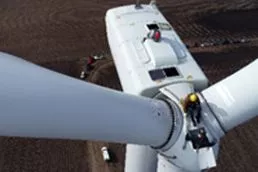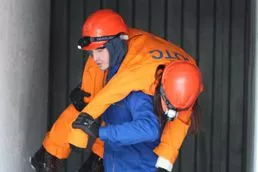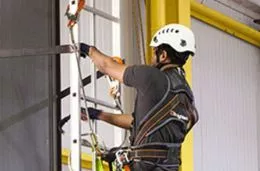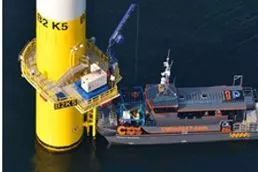GWO Training Courses
Global Wind Organisation (GWO) certification is mandatory for anyone working in the wind sector both onshore and offshore. Lerus Training Centre is GWO Certified Training Provider who offers GWO Basic Safety Standard Training that covers 5 modules:
- First Aid
- Fire Awareness
- Manual Handling
- Working at Heights
- Sea Survival
The members of the Global Wind Organisation (GWO) recognize trained persons as competent within Basic Safety in the wind industry and accept the trained person as possessing the required knowledge to stop an unsafe work situation where they as duty-holders are accountable for safety.
| Average Student Feedback score of our training centre is: Official GWO Figure |
GWO BST Training:
- Contributes to your awareness of the hazards that may be encountered when working within the wind energy industry;
- Contributes to your knowledge and understanding of how to control and mitigate hazards associated with work within wind energy industry;
- Provides you with knowledge and necessary skills to respond to possible emergencies and increases your personal safety through proper use of Personal Protective Equipment (PPE), emergency equipment and procedures.
Gain the Benefits of GWO Training
In today's rapidly growing renewable energy sector, keeping up with industry standards and maintaining a high level of safety is crucial. One way that both employers and employees can ensure they are well-prepared and equipped for the demanding tasks ahead is through GWO training. Understanding the importance of GWO training is essential in maximizing the benefits it brings to both individuals and organizations alike.
Understanding the Importance of GWO Training
The renewable energy sector is booming, with wind energy playing a pivotal role in sustainable power generation. As the demand for skilled workers in this field increases, it becomes essential to prioritize safety and efficiency. GWO training serves as a comprehensive program that equips workers with the necessary skills and knowledge to perform their tasks safely and effectively.
When it comes to working in the renewable energy sector, particularly in wind energy, safety is of utmost importance. The nature of the work, which often involves climbing turbines and working at great heights, poses significant risks. GWO training addresses these risks head-on by providing workers with the necessary training to handle tasks related to wind turbine installation, operation, and maintenance.
The Role of GWO Training in the Renewable Energy Sector
GWO training plays a vital role in the renewable energy sector by ensuring that workers are equipped with the necessary skills to handle tasks related to wind turbine installation, operation, and maintenance. From climbing turbines to working at heights, GWO training covers a range of critical aspects needed to execute these tasks safely.
One of the key areas covered in GWO training is the proper use of personal protective equipment (PPE). Workers are taught how to select and use the appropriate PPE for different tasks, ensuring that they are adequately protected from potential hazards. This includes understanding the importance of wearing safety harnesses, helmets, and other protective gear while working at heights.
In addition to PPE, GWO training also emphasizes the importance of effective communication and teamwork. Workers learn how to communicate effectively with their colleagues, ensuring that tasks are carried out smoothly and efficiently. This not only enhances safety but also improves overall productivity on worksites.
Safety and Efficiency: Core Principles of GWO Training
The core principles of GWO training revolve around safety and efficiency. By providing workers with the skills and knowledge needed to identify and minimize risks, GWO training enhances safety standards on worksites. This ultimately reduces the likelihood of accidents and injuries, promoting a safer working environment for everyone involved.
Efficiency is another crucial aspect of GWO training. Workers are trained to perform their tasks in a manner that maximizes productivity while minimizing risks. This includes learning efficient techniques for climbing turbines, conducting inspections, and carrying out maintenance work. By optimizing workflows and ensuring that tasks are completed in a timely and efficient manner, GWO training contributes to the overall success of renewable energy projects.
Moreover, GWO training also emphasizes the importance of continuous learning and improvement. As the renewable energy sector evolves, new technologies and best practices emerge. GWO training equips workers with the knowledge and skills needed to adapt to these changes, ensuring that they remain competent and up-to-date in their roles.
Key Components of GWO Training
GWO training encompasses various key components that ensure workers are equipped with a comprehensive skill set to tackle the challenges they may encounter. From first aid training to fire awareness and safety measures, each component serves a specific purpose in promoting safety and efficiency.
First Aid Training: A Vital Component
First aid training is a vital component of GWO training as it equips workers with the necessary skills to administer immediate medical assistance in the event of an injury. By having trained personnel on site, the response time can be significantly reduced, ultimately minimizing the severity of injuries and saving lives.
During first aid training, workers learn various techniques such as CPR, wound management, and basic life support. They are taught how to assess the situation quickly and provide appropriate medical care until professional help arrives. This training not only benefits the workers themselves but also creates a safer working environment for everyone involved.
Furthermore, first aid training also includes education on recognizing and responding to specific medical emergencies that are common in the renewable energy sector. Workers learn how to identify symptoms of heat exhaustion, hypothermia, and other weather-related conditions that can occur while working in extreme conditions.
Fire Awareness and Safety Measures
Working in the renewable energy sector involves working with electrical equipment, which poses certain fire hazards. GWO training includes comprehensive fire awareness and safety measures, ensuring that workers are well-prepared to prevent, contain, and extinguish fires effectively.
During fire awareness training, workers are educated on the different types of fires that can occur in a wind turbine or other renewable energy installations. They learn how to identify potential fire hazards, such as faulty electrical connections or overheating equipment, and take appropriate preventive measures.
Workers also receive hands-on training on how to use fire extinguishers and other firefighting equipment. They learn about the different types of extinguishers and which ones are suitable for specific types of fires. This knowledge enables them to respond quickly and effectively in case of a fire emergency, minimizing the risk of property damage and injuries.
Working at Heights: Risks and Precautions
A significant aspect of GWO training revolves around working at heights – a task that is often a part of wind turbine maintenance and installation. GWO training equips workers with the necessary knowledge and skills to work safely at elevated heights, minimizing the risk of falls and other accidents.
During working at heights training, workers learn about the potential risks associated with working in elevated positions. They are educated on the importance of using appropriate fall protection equipment, such as harnesses and lanyards, to prevent falls. Workers also learn how to inspect and properly use this equipment to ensure their safety.
In addition to fall protection, workers are trained on how to navigate and work on various structures at heights. They learn about the importance of maintaining a secure footing, using proper handholds, and following safety protocols to minimize the risk of accidents.
GWO training also emphasizes the importance of regular equipment inspections and maintenance to ensure that all safety measures are in place. Workers are taught how to identify potential hazards, such as damaged safety equipment or structural weaknesses, and report them for immediate action.
By providing comprehensive training on working at heights, GWO ensures that workers are well-prepared and confident in their ability to perform their tasks safely and efficiently.
The Benefits of GWO Training for Employers
Employers in the renewable energy sector stand to gain numerous benefits by investing in GWO training for their workforce. GWO training ensures that workers are fully aware of safety protocols and standards, creating a culture of safety within the organization. This leads to a significant reduction in accidents, injuries, and lost work hours, ultimately enhancing overall workplace safety.
Furthermore, GWO training goes beyond just safety measures. It also focuses on enhancing the skill set and knowledge base of employees. By providing their employees with GWO training, employers can boost their confidence and improve their efficiency. With a more confident and efficient workforce, companies can complete projects on time and meet client expectations, leading to increased customer satisfaction and business growth.
Enhancing Workplace Safety
GWO training plays a crucial role in enhancing workplace safety. It equips workers with the necessary knowledge and skills to identify potential hazards and take appropriate preventive measures. By ensuring that workers are fully aware of safety protocols and standards, GWO training creates a culture of safety within the organization.
Workers who have undergone GWO training are well-versed in emergency response procedures, first aid techniques, and working at heights. They understand the importance of wearing personal protective equipment (PPE) and follow proper safety guidelines. This comprehensive training significantly reduces the risk of accidents, injuries, and fatalities in the workplace.
Moreover, GWO training also emphasizes the importance of regular equipment inspections and maintenance. Workers are trained to identify any faults or defects in equipment and report them promptly. This proactive approach to equipment safety ensures that potential hazards are addressed before they can cause harm.
Boosting Employee Confidence and Efficiency
Investing in GWO training not only enhances workplace safety but also boosts employee confidence and efficiency. By providing employees with the necessary skills and knowledge, employers empower them to perform their tasks more efficiently and effectively.
When employees undergo GWO training, they gain a deeper understanding of their roles and responsibilities. They become more proficient in using specialized tools and equipment, which allows them to complete tasks with greater accuracy and speed. This increased efficiency translates into improved productivity and cost-effectiveness for the company.
Furthermore, GWO training instills a sense of confidence in employees. They feel more competent and capable in their jobs, which leads to increased job satisfaction and motivation. This, in turn, has a positive impact on employee morale and overall team dynamics.
With a confident and efficient workforce, companies can tackle complex projects with ease. They can meet project deadlines, deliver high-quality work, and exceed client expectations. This level of professionalism and competence not only enhances the company's reputation but also opens up opportunities for business growth and expansion.
The Benefits of GWO Training for Employees
GWO training not only benefits employers but also has numerous advantages for employees in the renewable energy sector.
Acquiring Essential Safety Skills
GWO training allows employees to acquire essential safety skills that are transferable across different industries. These skills not only enhance their employability but also increase their confidence in performing tasks safely and efficiently.
Career Advancement Opportunities
With GWO training on their resume, employees open the doors to greater career advancement opportunities in the renewable energy sector. They become more attractive to potential employers who prioritize safety and are more likely to secure higher-paying positions or receive promotions within their current organization.






















